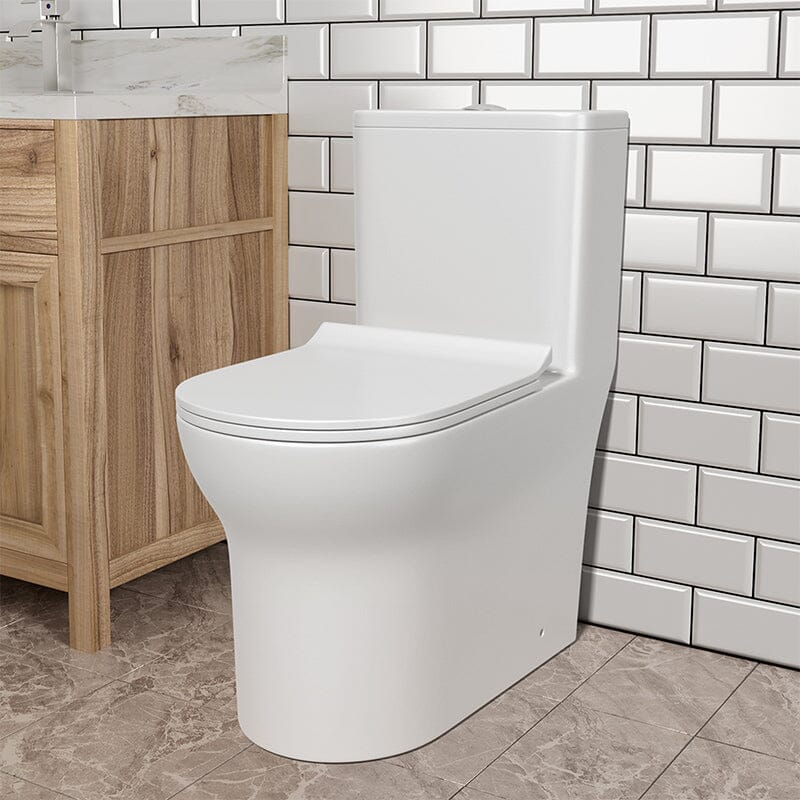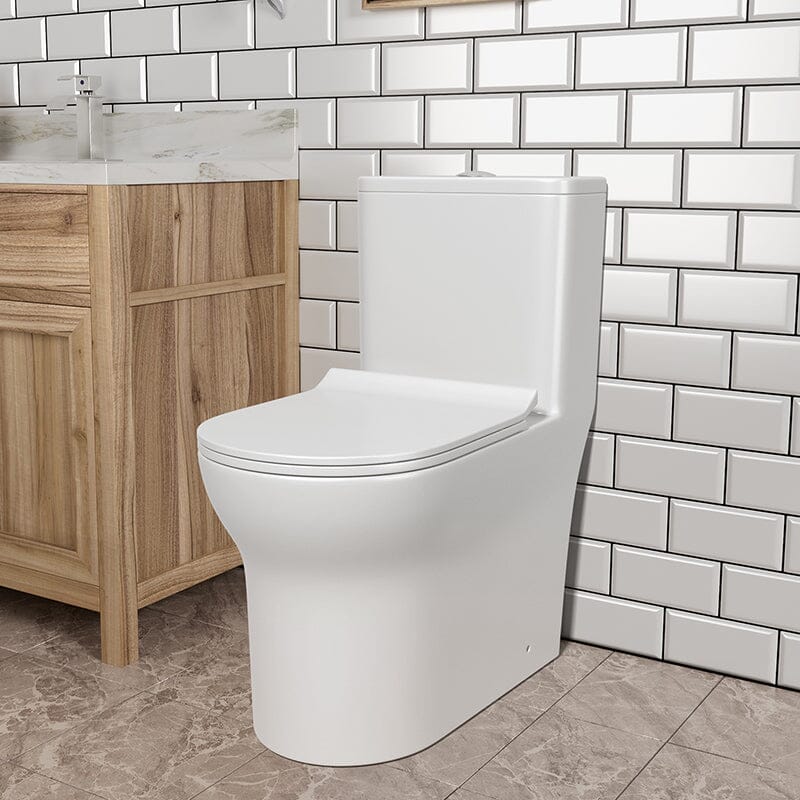Toilets are an essential part of modern sanitation, and among the various types of toilets, siphonic toilets stand out for their efficient waste removal and water-saving features. Understanding what a siphon is and how it functions within a toilet can help homeowners make informed choices about their bathroom fixtures. So let’s get started!

The Mechanics of Siphonic Toilet
At its core, the siphon principle is a fundamental concept in fluid dynamics that allows liquid to flow from a higher elevation to a lower elevation through a tube, utilizing gravity and atmospheric pressure. This principle is cleverly applied in toilets to create a vacuum effect that efficiently removes waste from the bowl.
When the toilet is flushed, water from the tank rapidly fills the bowl, causing the water level to rise. As the water level increases, it flows into the trapway, which is typically designed in a reverse "P" or "S" shape. This specific design is crucial as it creates a vacuum effect, effectively pulling waste out of the bowl and into the plumbing system.
Types of Siphonic Toilets
-

Vortex Siphon
Vortex siphon technology is commonly found in one-piece toilets, where the flushing outlet is located on one side of the toilet's base. When the user presses the flush button, water flows along the inner wall of the toilet, creating a powerful vortex. This design not only increases the scouring force of the water flow against the inner wall but also enhances the suction of the siphon effect.
-

Jet Siphon
Jet siphon is a more popular flushing method in recent years, and many smart toilets utilize this design to ensure thorough cleaning. This method incorporates a secondary jetting channel aligned with the center of the drainage outlet at the bottom of the toilet. During flushing, a portion of the water flows out through the distribution holes around the toilet rim, while another portion is ejected from the jetting outlet.
Do I Need a Siphon Toilet?
To answer this question, it’s better to consider the pros and cons of siphon toilets to determine if they meet your needs.
Advantages
- Efficient Water Use: Modern toilet designs, in accordance with regulations like the Energy Policy Act of 1992, aim to maximize waste removal with minimal water usage, limiting flush volume to 1.6 gallons per flush. The siphon design optimizes this limited capacity through strong suction, ensuring effective waste removal while conserving water.
- Quiet Operation: Compared to other flushing systems, siphon toilets minimize noise due to controlled water flow and siphoning action, making them quieter in operation. This creates a more pleasant experience in shared spaces and nighttime environments.
- Cleaner Bowl: The swirling motion of water filling the bowl during each flush means the toilet remains cleaner after each use. The effective siphoning action helps prevent waste from adhering to the bowl's surface, reducing the frequency of necessary cleanings.
Disadvantages
- Prone to Clogging: The narrow design of the drainage pipe can lead to clogs, especially if inappropriate items are flushed. Homeowners may need to keep a plunger on hand for emergencies. Further Reading: "Siphon Toilet Troubleshooting: Clogs, Leaks and Flushing Issues".
- Size Limitations: The drainage design of siphon toilets typically requires more space, which may be a consideration for small bathrooms with limited room.
- Initial Cost: The initial purchase price of siphon toilets may be higher than other models, particularly high-efficiency or designer versions. However, over time, savings on water bills and fewer plumbing issues may offset this expense.
4 Recommended Siphon Toilets
-
Tankless Elongated Smart Bidet Toilet with Heated Seat, Drying, Night Light

 Tankless Elongated Smart Bidet Toilet with Heated Seat, Drying, Night Light
Tankless Elongated Smart Bidet Toilet with Heated Seat, Drying, Night Light- Regular price
-
From
$899.99 - Regular price
-
$1,099.99 - Sale price
-
From
$899.99
Quick view
-
Smart Bidet Toilet with Elderly and Child Modes

 Smart Bidet Toilet with Elderly and Child Modes
Smart Bidet Toilet with Elderly and Child Modes- Regular price
-
$799.99 - Regular price
-
$999.99 - Sale price
-
$799.99
Quick view
-
Dual Flush Elongated One Piece Toilet with Soft Close Seat Cover High-Efficiency Flush

 Dual Flush Elongated One Piece Toilet with Soft Close Seat Cover High-Efficiency Flush
Dual Flush Elongated One Piece Toilet with Soft Close Seat Cover High-Efficiency Flush- Regular price
-
$299.99 - Regular price
-
- Sale price
-
$299.99
Quick view
-
Giving Tree 1.1/1.6 GPF Dual Flush Elongated One-Piece Toilet Floor Mount

 Giving Tree 1.1/1.6 GPF Dual Flush Elongated One-Piece Toilet Floor Mount
Giving Tree 1.1/1.6 GPF Dual Flush Elongated One-Piece Toilet Floor Mount- Regular price
-
$299.99 - Regular price
-
$599.99 - Sale price
-
$299.99
Quick view
Ending
In summary, siphonic toilets provide a compelling combination of efficiency and performance, making them a popular choice for homeowners. Their ability to effectively remove waste while conserving water enhances bathroom functionality and ensures a quieter, cleaner environment. However, it's important to consider potential drawbacks, such as the risk of clogging and space requirements. Ultimately, your decision should align with your specific needs and bathroom layout. By carefully weighing these factors, you can determine if a siphon toilet is the right fit for your home, ensuring a worthwhile investment in your bathroom experience.
More Ideas
-

Does Not Flushing the Toilet Really Save Money?
Think skipping toilet flushes saves money? Think again! Discover why not flushing can lead to hygiene issues, plumbing damage, and even social discomfort. Learn smarter ways to save water and...
-

Should You Close the Toilet Lid Before Flushing
Wondering if you should close the toilet lid when flushing? This article explains the science behind gravity and siphon flush toilets and offers surprising insights on how to reduce bacteria...
-

5 Creative Ideas for Gray Bathroom Tiles
Discover five creative gray bathroom tile ideas to elevate your space. From floral designs that add vibrancy to bold gray and white contrasts, these tips tackle common design challenges, offering...
-

Everything You Need to Know About Concrete Bathtubs
Discover everything you need to know about concrete bathtubs! From their durability and industrial aesthetic to the pros and cons, this guide helps you decide if this unique, customizable option...
-

What is Solid Surface Material?
Discover the versatility and elegance of solid surface materials. From sleek kitchen countertops to stylish bathroom vanities, learn how this durable, easy-to-maintain, and eco-friendly material is transforming modern design. Explore...
-

How to Remove Yellow Stains from a Bathtub
Learn how to remove yellow stains from your bathtub caused by hard water, chemicals, or aging materials. Discover natural cleaning tips and expert techniques to restore your tub’s shine and...
















